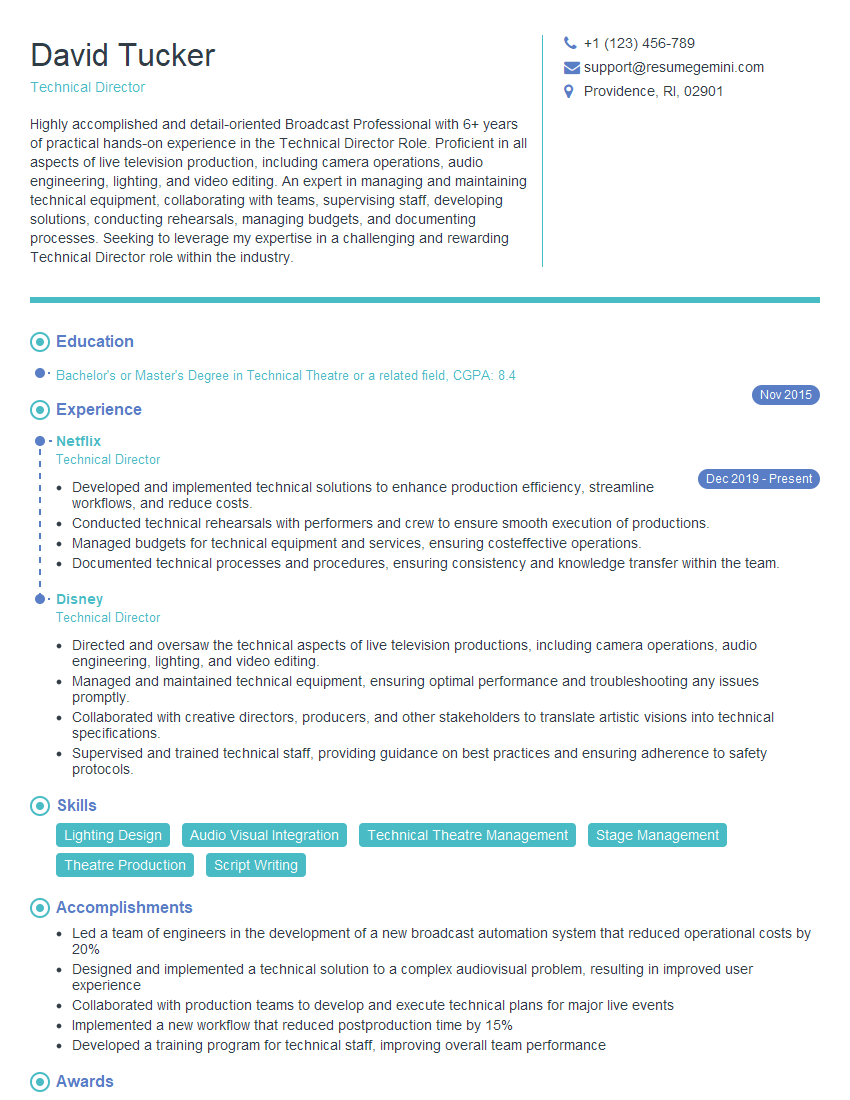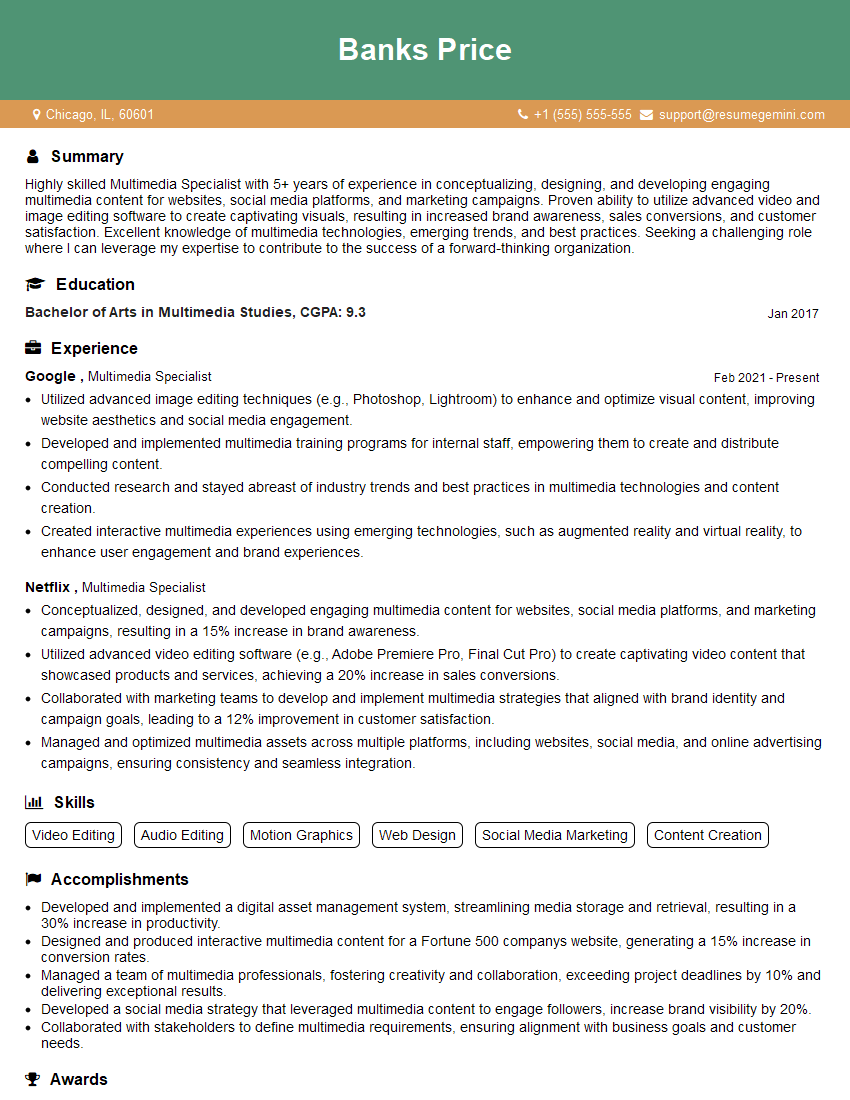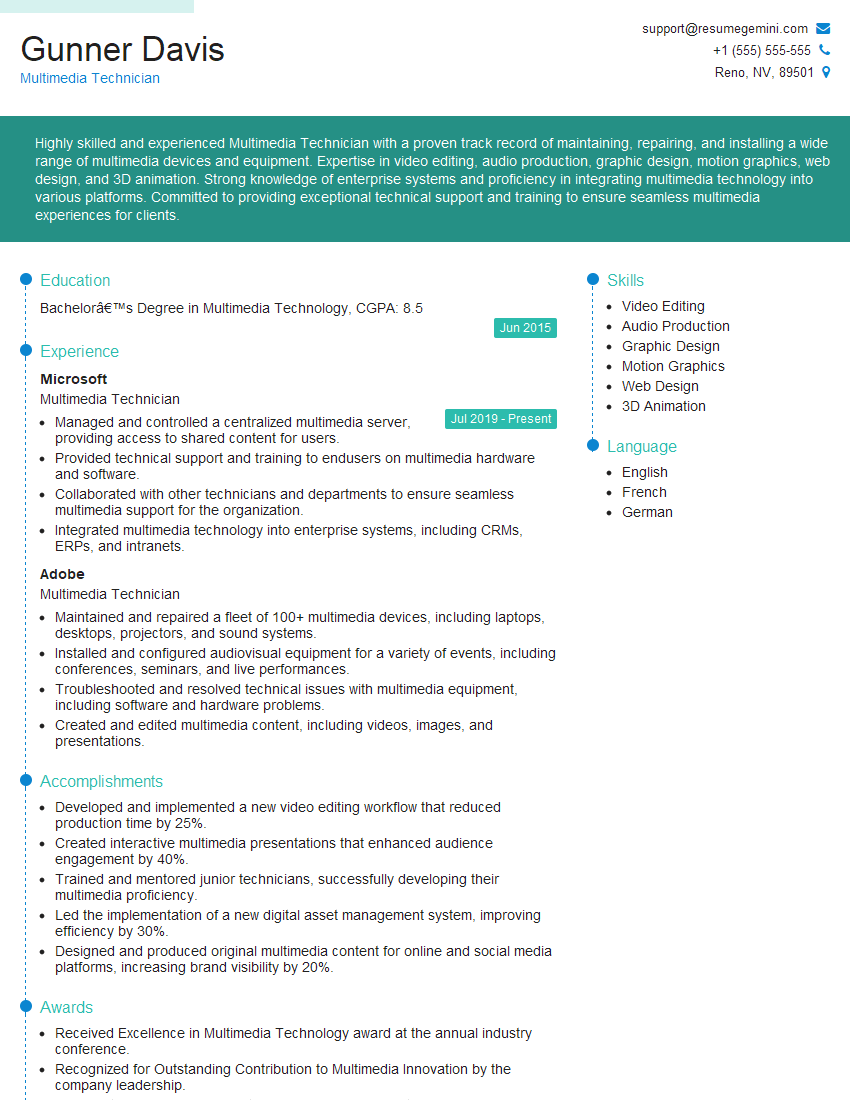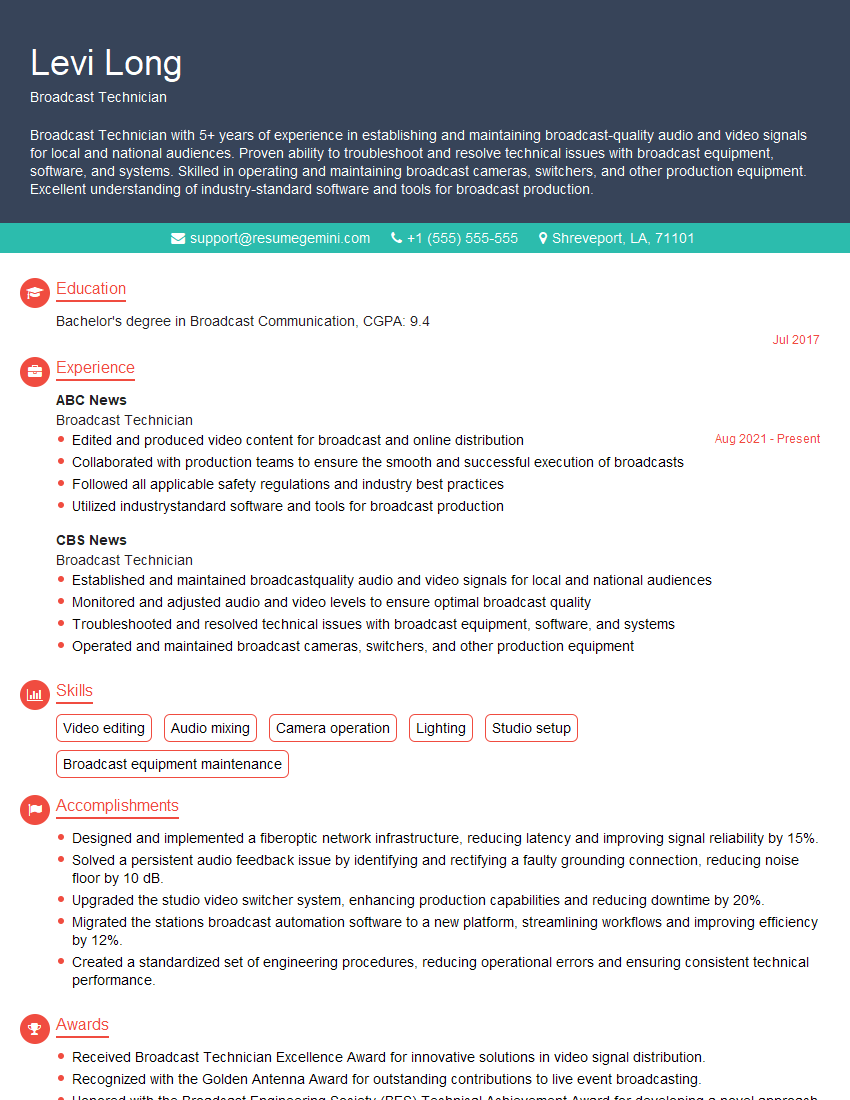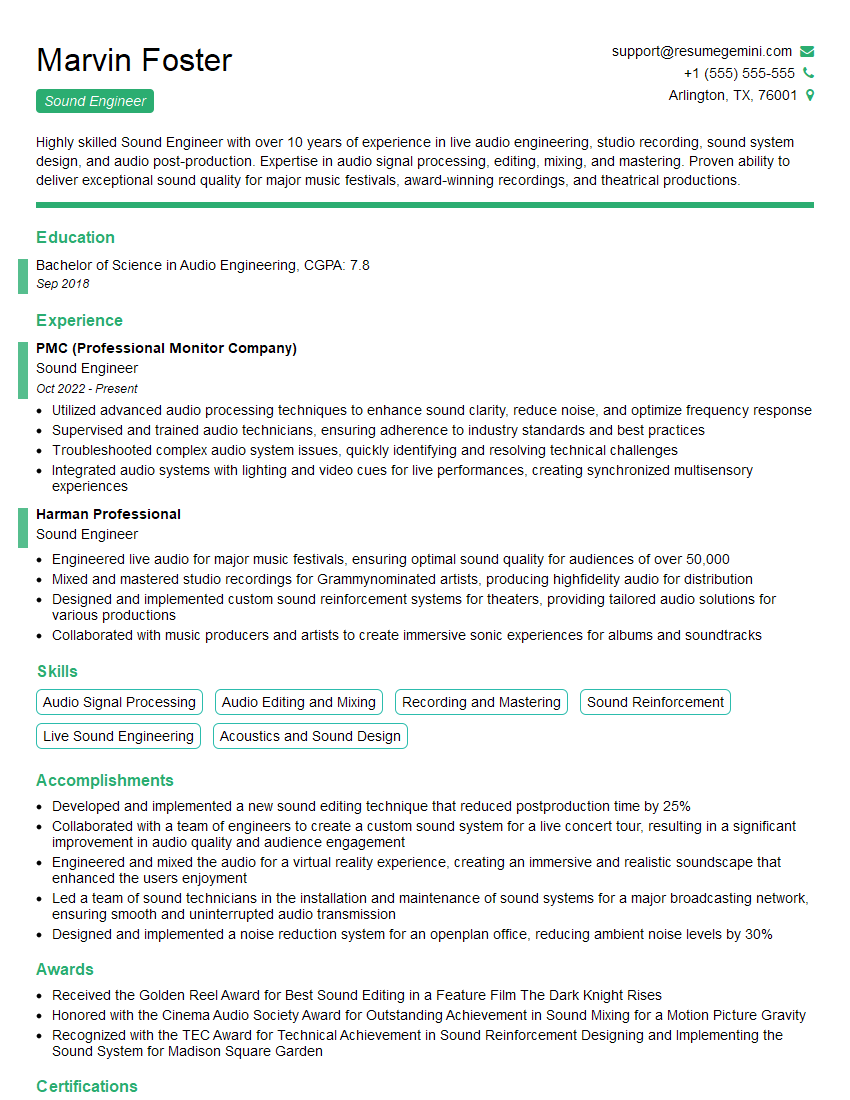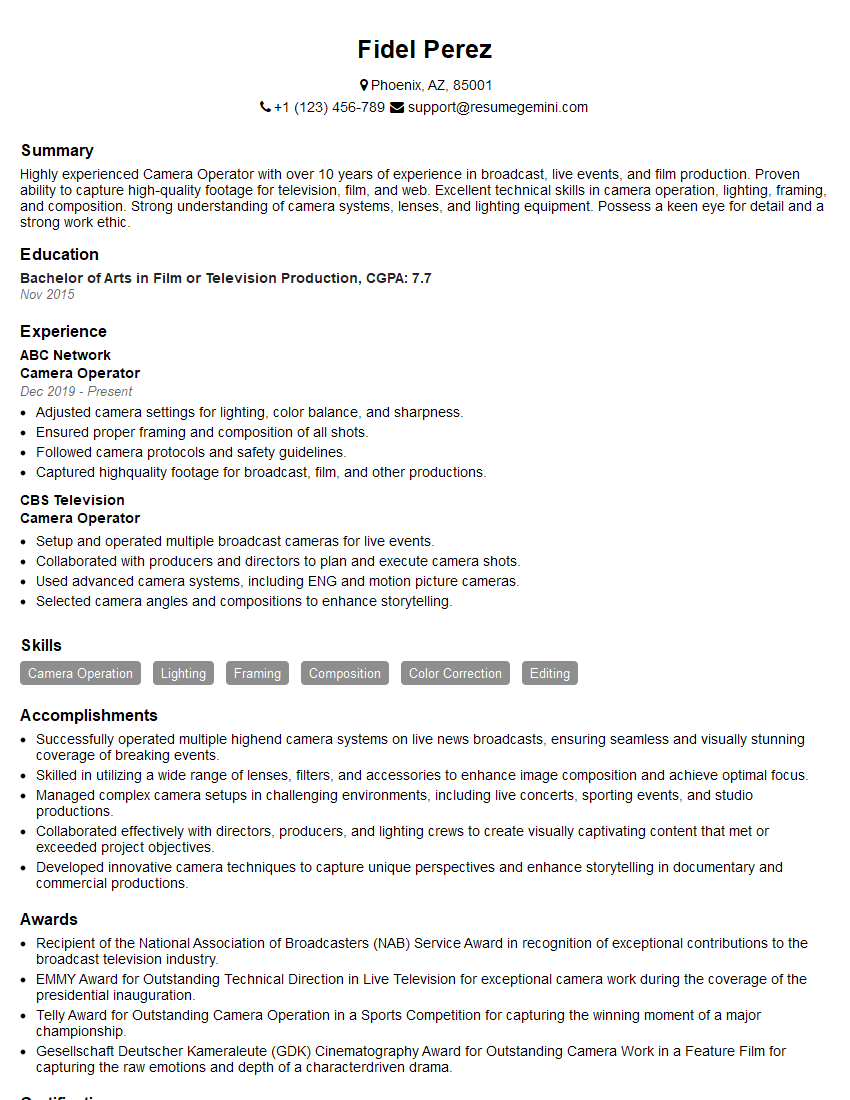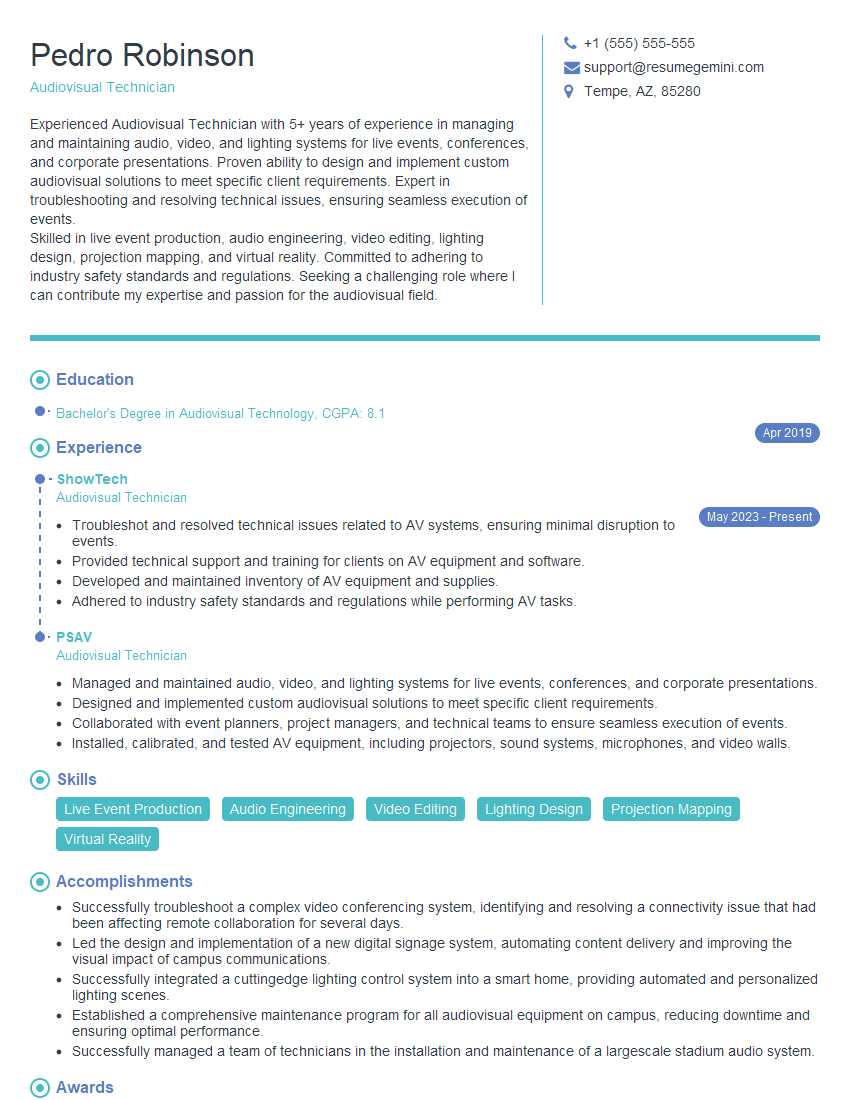The thought of an interview can be nerve-wracking, but the right preparation can make all the difference. Explore this comprehensive guide to Audiovisual Equipment Setup and Troubleshooting interview questions and gain the confidence you need to showcase your abilities and secure the role.
Questions Asked in Audiovisual Equipment Setup and Troubleshooting Interview
Q 1. Describe your experience with setting up and troubleshooting video conferencing systems.
Setting up and troubleshooting video conferencing systems involves a multifaceted approach, encompassing hardware, software, and network configurations. My experience spans various platforms, from Zoom and Teams to specialized enterprise solutions. I’m proficient in diagnosing issues related to audio and video quality, network connectivity, and software compatibility. For example, I once resolved a persistent echo problem in a large conference room by identifying a faulty microphone placement and implementing acoustic treatment. Another time, I debugged a video streaming issue caused by insufficient network bandwidth by optimizing network settings and implementing QoS (Quality of Service) policies. My approach always starts with a thorough assessment of the system’s components and network infrastructure, followed by a systematic process of elimination to pinpoint the root cause.
- Hardware diagnostics: Checking camera, microphone, and speaker functionality, including cable connections and power supply.
- Software configuration: Ensuring proper driver installation, application settings, and compatibility with operating systems.
- Network analysis: Evaluating bandwidth availability, network latency, and potential conflicts using network monitoring tools.
- Troubleshooting techniques: Utilizing remote access tools, log analysis, and manufacturer’s support documentation.
Q 2. How familiar are you with different audio mixing consoles and their functionalities?
My familiarity with audio mixing consoles extends to both analog and digital systems, encompassing various brands like Yamaha, Soundcraft, and Allen & Heath. I understand their core functionalities, including channel equalization, gain staging, routing, effects processing, and signal monitoring. I’m comfortable working with both small-scale mixers for presentations and larger consoles for multi-track recordings and live events. I can operate and configure these consoles to achieve specific acoustic goals, whether it’s enhancing vocal clarity, creating a balanced mix, or managing feedback issues. For instance, I’ve used a Yamaha MG series mixer for small presentations, tailoring EQ settings to compensate for room acoustics. With larger Allen & Heath consoles, I’ve managed complex audio routing for multi-camera productions, ensuring seamless audio transitions between sources.
Q 3. Explain your process for diagnosing and resolving issues with projector malfunctions.
Diagnosing projector malfunctions involves a structured approach. My process begins with a visual inspection, checking for obvious issues like loose cables or power supply problems. Next, I’ll systematically test each component. I’ll check the projector’s power source, lamp status, and input signal. A common issue is a faulty lamp, easily identified by a dim or flickering image. The next step involves confirming signal integrity by checking the source device and the cable connection. I’ve often found that the simplest problems, like a loose cable or an incorrect input setting, were responsible for projector malfunctions. Then, if the problem persists, I’ll investigate more advanced issues, such as the projector’s internal components and consider seeking professional repair.
- Visual Inspection: Check for loose cables, damaged components, and power supply issues.
- Power and Lamp Check: Verify the projector’s power and lamp functionality.
- Signal Verification: Check the source device, cable connection, and input settings.
- Advanced Diagnostics: If the issue persists, investigate internal components or seek professional assistance.
Q 4. What troubleshooting steps would you take if a microphone was not working during a presentation?
Troubleshooting a non-functional microphone during a presentation requires a methodical approach. First, I’d visually inspect the microphone and its connection. Often, a simple fix is a loose cable or an incorrectly selected input source. Next, I’d check the microphone’s power source (if it’s a powered microphone) and ensure it’s properly switched on. Then, I’d confirm that the correct audio input is selected on the mixer or sound system. Another possible issue is a faulty microphone, which I would check by swapping with a known working one. If all else fails, I would then check for signal level issues on the mixing console. I would also assess if the problem is specific to the microphone or pervasive across the audio system.
- Visual Inspection: Check the microphone and cable connections.
- Power Source: Verify the microphone’s power source (if applicable).
- Input Selection: Ensure the correct audio input is selected on the mixer/sound system.
- Microphone Functionality: Test with a known working microphone.
- Signal Level Check: Inspect signal levels on the mixing console.
Q 5. Describe your experience with different types of audio cables and connectors.
My experience encompasses a wide range of audio cables and connectors, from XLR and 1/4-inch TRS/TS to RCA and various digital formats like AES/EBU and optical Toslink. I understand the differences in their impedance, shielding, and signal transmission capabilities. I’m mindful of choosing the appropriate cable for each application. For example, XLR cables are preferred for professional audio applications because of their balanced signal transmission, reducing noise and interference. While RCA cables are suitable for consumer-grade audio, their unbalanced nature makes them more susceptible to noise. This understanding allows me to choose the appropriate cable based on the application requirements ensuring reliable signal transmission.
Q 6. How do you test and verify audio signal levels?
Testing and verifying audio signal levels is crucial for achieving optimal audio quality and preventing distortion. This involves using a combination of visual and auditory monitoring techniques. I use meters on audio mixing consoles and audio interfaces to check peak and average signal levels. Aiming for optimal levels is vital, avoiding both clipping (excessive signal levels) and weak signals prone to noise. Auditory monitoring using headphones and speakers provides crucial context, ensuring the sound is balanced, avoiding unwanted sounds such as hum or excessive hiss. A multimeter can further assess signal strength, verifying that the voltage is within the acceptable range for the particular equipment. This multi-faceted approach to signal level management ensures clear, high-quality audio output.
Q 7. What are your preferred methods for managing cables and wiring in an AV setup?
Effective cable management is paramount for a professional AV setup. My preferred methods emphasize organization, accessibility, and safety. I use cable ties, Velcro straps, and labeled cable markers to keep cables neat and organized. I often employ cable trays and conduits to route cables along walls and floors, minimizing tripping hazards and enhancing aesthetics. For larger installations, I utilize dedicated cable management systems that allow for easy access and future expansion. Proper labeling is essential for troubleshooting and future maintenance. I always prioritize safety, ensuring cables are routed away from high-traffic areas and secured to prevent accidental damage or disconnection. A well-organized cable system enhances efficiency, reduces troubleshooting time, and creates a safer working environment.
Q 8. Explain your experience with various video formats and resolutions.
My experience encompasses a wide range of video formats and resolutions, from standard definition (SD) like 480i and 480p to high definition (HD) such as 720p and 1080i/p, and extending to ultra-high definition (UHD) or 4K (3840×2160) and even 8K resolutions. I’m familiar with various compression codecs like H.264, H.265 (HEVC), and VP9, understanding their impact on file size, quality, and bandwidth requirements. For instance, in a recent project involving a large-scale video wall, we opted for H.265 encoding to minimize storage needs and network strain while maintaining exceptional image quality. I also have hands-on experience with different video signal interfaces, including HDMI, DisplayPort, SDI (Serial Digital Interface), and DVI, understanding their respective bandwidth capabilities and limitations. Choosing the right format and resolution is critical for optimizing visual quality and system performance, a decision that depends heavily on the display technology, content source, and network infrastructure.
For example, using 4K content on a 1080p display is unnecessary and might even cause compatibility issues, while using a lower resolution on a high-resolution display will result in a downscaled image.
Q 9. How do you ensure compatibility between different AV devices?
Ensuring compatibility between AV devices requires a systematic approach. First, I meticulously check the device specifications, paying close attention to input/output signal types (HDMI, DisplayPort, VGA, etc.), resolutions, and supported video formats. I also verify the presence of necessary conversion equipment like scalers or converters if there’s a mismatch between source and display capabilities. For example, if a source outputs SDI and the display accepts only HDMI, an SDI to HDMI converter is crucial. Second, I conduct thorough testing during the setup phase, meticulously checking signal flow and image quality at each stage. Problems like incorrect aspect ratios, color discrepancies, or resolution incompatibility are addressed promptly using appropriate tools and techniques. Finally, I always prioritize using standardized cabling and connectors. Proper grounding and shielding are crucial in minimizing signal noise and interference, enhancing system stability and reliability.
For example, in a corporate boardroom setup, I had to ensure that laptops, Blu-ray players, and a document camera all fed into a central display. By meticulously checking specifications and employing appropriate adapters, I ensured seamless signal flow and consistent image quality.
Q 10. What is your experience with installing and configuring video wall displays?
I have extensive experience installing and configuring video wall displays, ranging from smaller configurations of four screens to large-scale installations with dozens of displays. This involves careful planning, precise mounting, and meticulous calibration to achieve seamless image alignment and consistent color across all screens. My process includes site surveys to assess the environment, selecting appropriate mounting hardware, and choosing suitable video processors to manage the signal distribution and control various aspects of the display. I’m proficient in using video wall controllers that enable features like bezel compensation (to minimize the visible seams between screens) and content management systems for easy scheduling and display of content. Careful consideration is given to environmental factors like ambient light and heat dissipation to ensure optimal performance and longevity.
In one recent project, we installed a 16-screen video wall in a control room. Accurate calibration was crucial, and we employed specialized software and techniques to ensure perfect alignment and color consistency across all screens. The project highlighted the importance of pre-planning and meticulous execution in achieving a visually stunning and reliable video wall installation.
Q 11. Describe your knowledge of digital signal processing (DSP) in AV systems.
Digital signal processing (DSP) plays a vital role in modern AV systems, enhancing audio quality and system functionality. I understand DSP concepts like equalization, delay adjustment, and filtering. In audio systems, DSP is used to correct for room acoustics, enhance clarity, and manage multiple audio sources. For example, I’ve used DSP to fine-tune the sound in a large auditorium, compensating for the inherent reverberation and ensuring even sound distribution throughout the space. In video systems, DSP can handle tasks like scaling, de-interlacing, and color correction, optimizing image quality and adapting video signals for different displays. I’m also familiar with the use of DSP in matrix switchers to route and process audio and video signals efficiently. My experience includes working with various DSP platforms and software interfaces to configure and manage these audio and video processing functions. This often includes programming and configuring the DSP to meet specific system requirements and optimize the overall audio and video experience.
Understanding DSP allows for the fine-tuning of audio and video signals, leading to a significantly improved and more enjoyable user experience.
Q 12. What are your troubleshooting techniques for network connectivity issues in AV systems?
Troubleshooting network connectivity issues in AV systems requires a systematic and methodical approach. My troubleshooting process typically starts with verifying basic connectivity – checking cables, network ports, and IP address configurations. I use network diagnostic tools like ping, traceroute, and network analyzers to identify bottlenecks or points of failure. Next, I examine network switches and routers for potential issues like port conflicts, bandwidth limitations, or faulty hardware. I also check for firewall restrictions or security settings that might be blocking AV traffic. Addressing network congestion is crucial, often requiring optimization of network bandwidth allocation or implementation of Quality of Service (QoS) policies. Additionally, I’m adept at identifying and resolving multicast and unicast issues relevant to streaming and distribution of audio-visual signals over a network.
For example, in a recent project, we encountered intermittent network dropouts affecting video streaming. Using packet analysis tools, we identified a faulty network switch causing packet loss. Replacing the switch quickly resolved the issue, highlighting the importance of systematic troubleshooting in complex network environments.
Q 13. How familiar are you with Crestron or AMX control systems?
I possess significant experience with Crestron and AMX control systems. I’m proficient in programming and configuring both platforms to control various AV components, including displays, projectors, audio systems, and lighting. I’m familiar with their respective programming languages (e.g., Crestron SIMPL+, AMX NetLinx) and can design and implement sophisticated control solutions for complex AV systems. This includes creating user-friendly interfaces (touch panels, web interfaces) and integrating control systems with other building management systems (BMS) or third-party devices. I’ve worked on projects ranging from small conference rooms to large auditoriums, designing and implementing control systems that provide seamless automation, centralized management, and intuitive user experiences.
My experience includes designing a Crestron control system for a large corporate campus, automating lighting, AV equipment, and room scheduling. This project highlighted the importance of a well-structured control system architecture and the power of automation in improving operational efficiency and user experience.
Q 14. Describe your experience with lighting control systems and protocols (e.g., DMX).
My experience with lighting control systems and protocols, particularly DMX (Digital Multiplex), is extensive. I can design, install, and program DMX-based lighting systems for various applications, from theatrical productions to corporate events. I’m familiar with different DMX controllers, lighting fixtures, and software packages. I understand the importance of proper cable management, addressing modes (e.g., 1990/512), and troubleshooting DMX signal issues. Beyond DMX, I have worked with other lighting control protocols, like Art-Net and sACN (Streaming ACN), which offer advantages such as scalability and network capabilities. My projects have included integrating lighting systems with other AV systems for synchronized and coordinated control. This enables creating dynamic and immersive environments where lighting complements and enhances the overall audio-visual experience.
In one project, I integrated a DMX lighting system with a Crestron control system to automate lighting scenes for a presentation hall. This allowed for seamless transitions between different lighting environments depending on the event or presentation taking place.
Q 15. What is your experience with setting up and troubleshooting wireless microphone systems?
Setting up and troubleshooting wireless microphone systems requires a multifaceted approach. It begins with understanding the system’s components – the transmitter, receiver, antennas, and the microphones themselves. Proper frequency coordination is crucial to avoid interference. I start by conducting a site survey to identify potential sources of interference, such as Wi-Fi routers, other wireless devices, and even metal structures that can obstruct the signal. Then, I carefully select appropriate frequencies using a spectrum analyzer to ensure a clean signal.
Troubleshooting often involves identifying the source of dropouts or audio artifacts. Common issues include low battery power, interference from other devices, faulty antennas, or incorrect frequency settings. My approach is systematic: I check each component, starting with the most obvious (batteries!), then move to antenna placement and signal strength, before investigating more complex issues such as RF interference or faulty equipment. For example, I once resolved a persistent dropout issue by simply repositioning the receiver antenna away from a metal filing cabinet that was significantly attenuating the signal. I always document the frequency settings and system configuration for easy reference and future troubleshooting.
Career Expert Tips:
- Ace those interviews! Prepare effectively by reviewing the Top 50 Most Common Interview Questions on ResumeGemini.
- Navigate your job search with confidence! Explore a wide range of Career Tips on ResumeGemini. Learn about common challenges and recommendations to overcome them.
- Craft the perfect resume! Master the Art of Resume Writing with ResumeGemini’s guide. Showcase your unique qualifications and achievements effectively.
- Don’t miss out on holiday savings! Build your dream resume with ResumeGemini’s ATS optimized templates.
Q 16. How do you maintain and document an AV system’s configuration?
Maintaining and documenting an AV system’s configuration is essential for long-term reliability and efficient troubleshooting. My documentation process is rigorous and includes both physical and digital components. Physically, I label all cables and equipment clearly with their function and location using a standardized labeling system. I also create detailed diagrams showing the layout of the system and the connections between components. These diagrams might be hand-drawn or created using CAD software depending on the complexity of the system.
Digitally, I utilize a comprehensive database to track equipment specifications, firmware versions, and any relevant maintenance records. This database typically includes serial numbers, purchase dates, and service history for each piece of equipment. For example, I might use a spreadsheet or dedicated asset management software. Crucially, I document any changes made to the system, including modifications to the configuration or software updates, along with the date and rationale for the change. This allows for easy rollback if necessary and helps prevent future issues.
Q 17. What safety precautions do you take when working with high-voltage equipment?
Safety is paramount when working with high-voltage equipment. I always adhere to strict safety protocols, including wearing appropriate personal protective equipment (PPE) such as insulated gloves and safety glasses. Before working on any equipment, I ensure the power is completely disconnected and locked out using a lockout/tagout (LOTO) procedure. This prevents accidental energization of the equipment. I regularly inspect cables and connectors for signs of damage before connecting them, and I avoid working alone whenever possible, always ensuring a colleague is available to assist in case of an emergency. Furthermore, I’m knowledgeable about emergency procedures and know exactly where the nearest emergency power-off switch is located. I treat high-voltage work with the utmost seriousness, always prioritizing safety over speed.
Q 18. Explain your experience with different types of video switchers and their functionalities.
My experience encompasses a wide range of video switchers, from basic production switchers to those with advanced features such as multiviewers and integrated audio processing. I’m proficient with both hardware and software-based switchers. Simple switchers offer basic source selection and transitions, while more advanced models offer features like DVE (Digital Video Effects), chroma keying, and image scaling. For instance, I have experience with switchers from brands like Blackmagic Design (ATEM), Ross Video, and Barco.
Each switcher has unique functionalities depending on its intended application. A production switcher used for live television broadcasting will have different capabilities than a presentation switcher used in a conference room. I understand the strengths and weaknesses of different types of switchers and can select the most appropriate one for a specific project based on the budget, technical requirements, and desired outcome. My understanding also extends to the various control protocols used with video switchers, allowing me to seamlessly integrate them within larger AV systems.
Q 19. How do you handle multiple simultaneous AV tasks during a live event?
Handling multiple simultaneous AV tasks during a live event requires meticulous planning and efficient execution. I employ a prioritized task list approach, focusing on critical tasks first. These tasks often include audio and video source management, ensuring smooth transitions, troubleshooting any technical issues that arise, and monitoring the overall system performance. My organizational skills are paramount, allowing me to stay calm and focused under pressure.
For example, I might have to troubleshoot a malfunctioning microphone while simultaneously managing a video transition and ensuring the streaming signal is clean and consistent. I rely on efficient communication with the event team, maintaining a clear understanding of their requirements and any changes to the schedule. Efficient workflow and pre-planning are key; pre-testing the entire system thoroughly before the event allows me to address any potential issues beforehand, allowing for a smoother live performance.
Q 20. What is your experience with audio equalization and acoustics?
Audio equalization and acoustics are crucial for achieving optimal sound quality. Equalization (EQ) involves adjusting the frequency response of an audio signal to compensate for room acoustics or to enhance specific aspects of the sound. I’m proficient in using graphic and parametric EQs to shape the sound, addressing issues such as muddiness in the low frequencies, harshness in the high frequencies, or poor vocal clarity.
Understanding acoustics involves considering the physical properties of a room, such as its size, shape, and the materials used in its construction. These factors influence how sound waves propagate and reflect within the space, affecting the overall sound quality. I use acoustic treatment such as sound absorbers and diffusers to manage reflections and reduce unwanted reverberation. For instance, I might use bass traps in the corners of a room to control low-frequency buildup, or strategically place acoustic panels to reduce echoes and improve speech intelligibility. This combined knowledge of EQ and acoustics is vital for delivering clear and well-balanced audio.
Q 21. Describe your experience with streaming platforms and protocols.
My experience with streaming platforms and protocols is extensive, covering various platforms like YouTube Live, Facebook Live, Twitch, and custom solutions. I understand the different protocols involved, such as RTMP (Real-Time Messaging Protocol), SRT (Secure Reliable Transport), and HLS (HTTP Live Streaming), and can select the optimal protocol based on the bandwidth, latency requirements, and streaming platform used.
I’m adept at configuring encoders and streaming software to achieve high-quality streams with minimal latency and bitrate optimization to balance quality and bandwidth usage. I also have experience with troubleshooting streaming issues, such as dropped frames, audio sync problems, and bandwidth limitations. My knowledge extends to working with various streaming hardware and software, enabling me to set up reliable and high-quality live streams for a variety of events and audiences.
Q 22. How do you prioritize tasks when dealing with multiple AV issues concurrently?
Prioritizing multiple AV issues requires a systematic approach. I use a tiered system based on urgency and impact. First, I identify issues impacting the core event – for example, a complete audio failure during a keynote speech takes precedence over a slightly misaligned projector. I assess each issue based on factors like:
- Criticality: How crucial is this system to the event’s success?
- Impact: How many attendees or event elements are affected?
- Urgency: How soon does this need to be resolved?
Using this framework, I create a prioritized list, tackling the most critical issues first. This often involves delegating tasks to team members if necessary, ensuring efficient resource allocation. For instance, if a microphone is malfunctioning during a breakout session while the main presentation is running smoothly, I’d likely assign a junior technician to fix the microphone while I supervise and address the main presentation’s technical needs.
Q 23. How do you stay updated with the latest trends and technologies in the AV industry?
Staying current in the rapidly evolving AV industry is paramount. My strategies include:
- Industry Publications and Websites: I regularly read trade publications like AV Technology and Sound & Video Contractor, and follow key websites for updates on new products and technologies.
- Professional Organizations: Membership in organizations like InfoComm provides access to webinars, conferences, and networking opportunities with other professionals.
- Vendor Training and Certifications: I actively participate in training sessions and workshops offered by major AV equipment manufacturers, obtaining certifications to demonstrate my expertise and stay abreast of their latest offerings. This includes hands-on experience with the newest technologies.
- Online Courses and Tutorials: Online platforms offer valuable resources for learning new skills and staying up-to-date with advancements in software and hardware.
This multi-pronged approach helps me ensure that I am consistently familiar with the newest hardware, software, and best practices in the field.
Q 24. Explain your experience with working in a team environment in AV setups.
Teamwork is essential in AV setups. My experience involves effective communication, delegation, and collaboration. I’ve worked on large-scale events with teams ranging from 2 to 20 people. My role often involves:
- Clear Communication: Establishing a shared understanding of goals, timelines, and responsibilities before starting a project is key. This includes regular updates throughout the process.
- Task Delegation: I assign tasks based on individual team members’ strengths and expertise, fostering efficiency and maximizing productivity. For example, I might assign cable management to a junior technician while I handle more complex audio setup tasks.
- Collaborative Problem-Solving: When facing challenges, I encourage open discussion and brainstorming among team members to find the best solution quickly. A second pair of eyes can identify something I might miss.
- Mentorship: I actively mentor junior technicians, sharing my knowledge and experience to foster professional growth.
In short, my team approach is built on clear communication, efficient delegation, and a collaborative mindset.
Q 25. Describe your understanding of the importance of health and safety regulations in AV work.
Health and safety regulations are paramount in AV work. This includes adhering to:
- Electrical Safety: Proper grounding, use of surge protectors, and understanding the risks of working with high voltage equipment are critical. I always double-check wiring and connections to prevent shocks and fires.
- Ergonomics: Setting up equipment in a way that minimizes strain and injury is essential. This involves proper lifting techniques, avoiding awkward postures, and using appropriate tools for the job.
- Risk Assessment: Before any setup, I conduct a risk assessment to identify potential hazards and implement preventive measures. This might include checking for trip hazards, ensuring proper ventilation, and providing safety training to team members.
- Confined Space Safety: When working in confined spaces like server rooms or ceilings, I strictly adhere to safety regulations related to ventilation, access, and fall prevention.
- Compliance with Local Regulations: I ensure that our setup complies with local building codes and safety regulations.
Neglecting safety regulations can lead to serious injury or property damage; it’s a priority I never compromise on.
Q 26. What is your experience with remote troubleshooting techniques?
Remote troubleshooting requires a different skillset. My experience includes:
- Remote Access Software: I’m proficient in using software like TeamViewer or AnyDesk to access and control client systems remotely. This allows me to diagnose problems and make adjustments without being physically present.
- Detailed Questioning: Gathering accurate information from the client is crucial. I use structured questioning to identify symptoms, isolate the problem, and guide them through troubleshooting steps.
- Diagnostic Tools: I utilize remote monitoring tools to access system logs, network status, and other diagnostic information. This allows me to pinpoint the root cause of the issue more efficiently.
- Clear and Concise Instructions: Explaining technical solutions in a way that a non-technical user can understand is crucial. I use simple language and avoid jargon whenever possible.
A recent example involved remotely diagnosing a video conferencing system issue. Through careful questioning and remote access, I identified a misconfigured network setting. After making the adjustments, the problem was resolved.
Q 27. How do you manage challenging clients or unexpected issues during an event?
Managing challenging clients or unexpected issues requires a calm and professional approach. I follow these steps:
- Active Listening: Understanding the client’s concerns is crucial. I actively listen to their feedback and validate their frustrations.
- Empathy and Patience: Technical issues can be stressful. Showing empathy and remaining patient helps de-escalate tense situations.
- Problem-Solving: I focus on finding solutions, not placing blame. I work collaboratively with the client to address the issue efficiently.
- Proactive Communication: Keeping the client updated on progress and potential delays is essential. Transparency builds trust and prevents misunderstandings.
- Contingency Planning: Having backup plans for unexpected issues (e.g., equipment failure) minimizes disruptions.
For instance, if a projector malfunctions during a crucial presentation, I immediately activate a backup projector while simultaneously troubleshooting the initial issue. My focus remains on minimizing disruption to the event, reassuring the client, and finding a swift resolution.
Q 28. Describe a time you had to troubleshoot a complex AV problem; explain your process and the outcome.
During a large corporate event, the main audio system experienced intermittent dropouts during a critical presentation. My troubleshooting process involved:
- Initial Assessment: I observed the problem, noting the frequency and duration of the dropouts. It appeared to be related to the audio mixer.
- System Checks: I checked all cables, connections, and power supplies. Everything appeared normal.
- Signal Tracing: Using test equipment, I traced the audio signal path to pinpoint where the signal was being interrupted. I discovered a loose connection within the audio mixer itself.
- Isolation and Resolution: I isolated the affected section of the mixer and found a faulty internal connection. With quick repair work, the issue was resolved.
- Testing and Prevention: After fixing the connection, I thoroughly tested the audio system to ensure stability. This included running a full sound check with the main speakers and mics.
The outcome was a successful restoration of audio, minimizing disruption to the event. After the event, I recommended a preventative maintenance schedule for the audio system to prevent similar problems in the future.
Key Topics to Learn for Audiovisual Equipment Setup and Troubleshooting Interview
- Audio and Video Signal Flow: Understanding how audio and video signals travel from source to display, including different connection types (HDMI, SDI, VGA, etc.) and signal processing.
- Equipment Operation and Configuration: Practical experience setting up and configuring various AV equipment such as projectors, screens, mixers, cameras, and microphones. This includes understanding settings, menus, and troubleshooting common operational issues.
- Troubleshooting Common AV Problems: Developing systematic approaches to diagnose and resolve issues like no signal, audio distortion, video lag, and connectivity problems. This includes using test equipment and understanding basic signal flow analysis.
- Networked AV Systems: Familiarity with networked AV systems, including control systems, streaming protocols, and troubleshooting network connectivity issues impacting audio-visual performance.
- Health and Safety Procedures: Understanding and adhering to safety regulations related to handling and operating AV equipment, including weight limits, power safety, and cable management.
- Testing and Calibration: Performing routine tests and calibrations on AV equipment to ensure optimal performance and image quality. This includes understanding concepts like color balance and audio levels.
- Documentation and Reporting: Maintaining clear and concise records of equipment setups, troubleshooting steps, and any maintenance performed.
Next Steps
Mastering Audiovisual Equipment Setup and Troubleshooting opens doors to exciting career opportunities in event management, corporate settings, broadcast, and more. A strong understanding of these skills is highly sought after, and demonstrating your expertise effectively is crucial for landing your dream job. Creating a professional, ATS-friendly resume is essential for getting noticed by recruiters. We recommend using ResumeGemini to build a standout resume that highlights your skills and experience in the best possible light. ResumeGemini provides examples of resumes tailored to Audiovisual Equipment Setup and Troubleshooting, giving you a head start in crafting your perfect application.
Explore more articles
Users Rating of Our Blogs
Share Your Experience
We value your feedback! Please rate our content and share your thoughts (optional).
What Readers Say About Our Blog
Hello,
We found issues with your domain’s email setup that may be sending your messages to spam or blocking them completely. InboxShield Mini shows you how to fix it in minutes — no tech skills required.
Scan your domain now for details: https://inboxshield-mini.com/
— Adam @ InboxShield Mini
Reply STOP to unsubscribe
Hi, are you owner of interviewgemini.com? What if I told you I could help you find extra time in your schedule, reconnect with leads you didn’t even realize you missed, and bring in more “I want to work with you” conversations, without increasing your ad spend or hiring a full-time employee?
All with a flexible, budget-friendly service that could easily pay for itself. Sounds good?
Would it be nice to jump on a quick 10-minute call so I can show you exactly how we make this work?
Best,
Hapei
Marketing Director
Hey, I know you’re the owner of interviewgemini.com. I’ll be quick.
Fundraising for your business is tough and time-consuming. We make it easier by guaranteeing two private investor meetings each month, for six months. No demos, no pitch events – just direct introductions to active investors matched to your startup.
If youR17;re raising, this could help you build real momentum. Want me to send more info?
Hi, I represent an SEO company that specialises in getting you AI citations and higher rankings on Google. I’d like to offer you a 100% free SEO audit for your website. Would you be interested?
Hi, I represent an SEO company that specialises in getting you AI citations and higher rankings on Google. I’d like to offer you a 100% free SEO audit for your website. Would you be interested?
good
